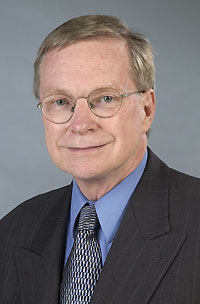For more archives, go to the Advance Archive/Search Page.
This semester begins my 22nd year at the University, and already it is shaping up to be one of the most exciting. During the period since 1983, I have had the opportunity to witness significant change in the life of the University. The academic year 2004-2005 promises to be one of the most transforming years in the University's history.
 |
Interim Provost Fred Maryanski |
At the June 22nd Board of Trustees meeting, I presented an approach to measuring the University's academic success against institutions in our peer group by using a set of easily understood measures, or "metrics," based upon nationally available data. Working with a group of colleagues during the early part of the summer, we settled on a set of 11 metrics, which characterize the University's standing in terms of undergraduate education, research, diversity, development, and reputation.
Using these measures, we identified a new set of peers among public universities. This group of institutions, Georgia, Iowa, Iowa State, Ohio State, Purdue, Minnesota, Missouri, and Rutgers, represents the next level through which UConn must advance in order to fulfill its goal of being recognized as a premier public university. This peer group clearly positions us as a national institution. It is our goal to be at the top of this group within five years.
In order for the University to realize these lofty ambitions, each unit must contribute to improving the metrics; and the University, at all levels, must allocate its resources in accordance with those goals. Initial metrics have been developed by the deans and vice provosts (and the library and student affairs) and will be refined in the coming months.
Those of us who reviewed the data quickly came to three conclusions.
- We are very competitive with
our peers in terms of undergraduate education.
- To realize our goals, we must substantially improve our scholarly
productivity.
- Our student-faculty ratio is two units higher than the average
of our peers (17:1, compared with 15:1).
It is clear that an essential element of enhancing the quality of our programs is increasing the size of our faculty. On July 23, the Board of Trustees' Academic Affairs Committee held a special meeting at which I proposed that the University increase the size of the faculty by 150 net positions over the next five years. This position was endorsed by the full Board during its Aug. 3 meeting.
Deans and regional campus associate vice provosts have been authorized to initiate the first 30 searches. Over the course of this fiscal year, the administration will develop a long-term plan for the funding of the 150 new positions. As indicated earlier, the internal metrics will drive future hiring and reallocation decisions.
I look forward to a continuing dialogue on these measures and hope to provide many ways to communicate our progress. Welcome to the new faculty who join our team this year. And my personal welcome and thanks to our returning faculty, who have made UConn the high quality institution it is today.
A copy of the Board of Trustees documents can be found at www.provost.uconn.edu.

